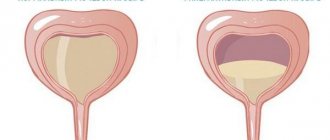A woman's health consists of many aspects. There are situations in which contacting a doctor is a mandatory aspect. A pathology requiring immediate medical intervention is blood in the urine (hematuria). Trouble always indicates the progression of serious problems in a woman’s body.
What are the causes of this pathology, what to do if blood is detected in the urine? Every woman, especially pregnant women, should know the answers to these questions. Possible negative factors of hematuria and effective treatment methods are described in the following material.
Probable causes of pathology development
The urine of a healthy person is a light yellow or transparent liquid with a specific odor. Any changes in the color of urine or the presence of impurities are a sign of a problem in the patient’s body. If urination is accompanied by attacks of pain, then, most likely, hematuria is associated with the release of stones, the flow. A painless process of emptying may indicate the presence of cancer or damage to internal organs.
It is difficult to independently determine the cause of the appearance of blood in the urine; specific studies are required to make a diagnosis. Today, there are more than 150 types of diseases that lead to the appearance of blood in the urine. All pathological conditions require treatment and lifestyle adjustments. Lack of medical care leads to severe complications, including death.
Doctors identify several probable causes of the formation of pathology:
- The most common disease leading to hematuria is urolithiasis. Damage to the walls of the excretory tract occurs against the background of the movement of stones. Urination with this disease is almost in all cases accompanied by pain;
- Inflammatory processes take second place. Pathogenic microorganisms damage the walls of blood vessels, red blood cells easily penetrate the urethra. The course of the inflammatory process is accompanied by an increase in body temperature, pain in the lumbar region;
- oncological formations. Tumors in the urinary system grow, damage the walls of the canals, which leads to the release of not only blood, but patients also find clots of red blood cells in the urine. The course of the oncological processes shows almost no signs of itself, urination occurs as usual, there is no discomfort;
- various injuries to the urinary system. Fresh blood clots appear in the urine;
- . An inflammatory process in the bladder is often diagnosed in women due to the specific structure of the urethra. Bacteria easily penetrate into it, then into the bladder, leading to cystitis. Blood in the urine characterizes the hemorrhagic form of the pathology; it is also characterized by the patient’s general malaise and pain during bowel movements;
- taking hormonal contraceptives. In some cases, drugs provoke blood stagnation and inflammatory processes in organs, which leads to the release of blood along with urine;
- Eating beets in large quantities, foods/medicines rich in dyes can lead to coloration of urine. Some patients perceive the color change as blood;
- menstrual irregularities. In such a situation, blood may be released from the vagina, and the woman will decide that red blood cells were in the urine. A similar situation is observed during pregnancy; many women mistake a small amount of blood in the urine for disturbances in the functioning of the excretory system, rather than the genital organs.
Hematuria code according to ICD 10 - N02 (recurrent stable), R31 (nonspecific hematuria).
Etiology
There are no physiological predisposing factors for the appearance of blood in the urine or for it to change its color. It follows from this that only pathological processes can be the causes. Due to the fact that the genitourinary system in men and women has several differences, it is quite natural that the sources of such a disorder will also differ.
Nevertheless, experts in the field of urology identify a list of causes of gross hematuria that are common to representatives of both sexes. It includes the following diseases:
- neoplasms in the bladder;
- tumors of a malignant or benign nature in the kidneys;
- the course of urolithiasis;
- the presence of an inflammatory process in the kidneys, ureters or bladder;
- damage to these organs by tuberculosis;
- pathologies of the genitourinary system of an infectious nature;
- genitourinary schistosomiasis;
- formation of a blood clot in the veins of the kidneys.
In addition, general factors also include:
- previous surgical interventions on the bladder.
- long-term addiction to such a bad habit as drinking alcohol.
- living in areas with increased background radiation.
In addition to the above reasons, the occurrence of such a manifestation in representatives of the male half of humanity can be influenced by:
- STD;
- benign prostatic hyperplasia;
- cancer of the prostate gland;
- excessively intense physical activity;
- acute form of urethritis;
- BPH;
- injury to the kidneys or bladder.
However, gross hematuria is most often observed in females, and there are several specific sources for this. The reasons for women are:
- the course of menstruation - while the appearance of such a sign is considered completely normal. This also includes the macrosomatic somatotype - this is a child who develops very quickly. In such cases, gross hematuria will be observed in girls during their first menstruation.
- rupture of the fallopian tube during ectopic pregnancy.
- cystitis.
- operations on the uterus.
- uncontrolled use of certain medications, in particular anticoagulants and oral contraceptives.
- fractures of the pelvic bones, which can lead to rupture of the bladder.
- the period of bearing a child - in such cases, the sign indicates the development of infectious diseases in the organs of the genitourinary system.
- diabetes mellitus
- systemic lupus erythematosus and other autoimmune diseases.
Symptoms
There are no characteristic signs of hematuria; symptoms depend on the underlying disease. Localization of pain can help in diagnosing pathology.
Clinical picture:
- characteristic of urolithiasis, cystitis. Hematuria without other symptoms often indicates cancer;
- inflammatory, traumatic pathologies are accompanied by elongated blood clots in brown urine;
- inability to defecate, the appearance of blood instead of urine means blockage of the urethra;
- a yellowish or greenish tint to the skin that accompanies hematuria indicates problems with the liver/gallbladder;
- pain in the side, in the area of the shoulder blades may indicate traumatic damage to the organ;
- large clots of red blood cells are characteristic of bladder ailments; oblong clots are characteristic of kidney problems;
- the discharge of blood along with stones or sand indicates the progression of urolithiasis.
Symptoms and diagnosis of the disease
Macrohematuria is not an independent disease. It is characterized by signs of the ailments against which it arose.
The symptoms of the disease are quite clear. The patient complains of weakness, severe back pain radiating to the shoulder blade. He has trouble urinating and his lower abdomen hurts. It is impossible to completely empty the bladder. Blood clots appear in urine.
Recommended topic:
Protein in urine during pregnancy
Urolithiasis disease
Various clinical symptoms need to be analyzed. Combinations of several signs will help the doctor determine the origin of hematuria.
It is possible to determine the source of pathology by analyzing pain sensations. In case of urolithiasis, pain precedes hematuria, and the bleeding is slight.
If a patient has painful, frequent urination with blood in the urine, this indicates pathologies such as a tumor, stone or inflammation.
Urinalysis according to Nechiporenko will help determine how many red blood cells are contained in urine. Cytological examinations of urine and culture are carried out to determine the presence and level of protein.
The source of bleeding is also determined by the shape of the clots. When it is localized in the kidneys or upper urinary tract, long, worm-like clots are formed. If the bleeding site is in the bladder, the clots take on a shapeless appearance.
Diagnostics
- general and biochemical analysis of blood and urine;
- urine culture to identify pathogenic microorganisms;
- gynecological examination, if necessary, checked for STIs and other specific diseases;
- and kidneys;
- examination by a proctologist.
Based on the data obtained, the doctor identifies the “root” of the problem and prescribes the appropriate course of therapy.
Important!
Only doctors can refute or confirm the diagnosis after conducting a series of studies. It is strictly forbidden to select treatment on your own!
Hematuria during pregnancy
Idiopathic hematuria in pregnant women can cause blood to appear in the urine. The phenomenon is often diagnosed at different stages of pregnancy. In the first trimester, pathology occurs against the background of hormonal disorders. In the later stages, blood clots in the urine are caused by mechanical damage to the urethra, kidneys, and uterus as a result of compression.
If the pathological process manifests itself after childbirth, additional diagnostics should be performed to identify the cause of hematuria. Sometimes the birth process leads to damage to the urinary system, which is not immediately noticeable. In any case, a consultation after detecting blood in the urine for a pregnant woman is a mandatory condition for the health of the woman and the unborn baby.
Treatment options for the disease
Treatment of hematuria requires elimination of the underlying disease.
Relief of unpleasant symptoms and lack of therapy will bring fleeting relief and will not eliminate the root cause of the pathology, which is fraught with sharply negative consequences.
Find out what it is and what functions it performs.
The page explains why a child has cloudy urine and what the symptom indicates.
Go to the address and read about the dangers of a left kidney cyst and how to get rid of the formation.
- To relieve pain, Dicinon, Vikasol, and potassium chloride solution (10%) are used. Large blood losses are compensated by infusion therapy. The doctor selects the drug, taking into account the characteristics of the patient and the specific ailment;
- the presence of stones in the ureter, urethra, it is recommended to take antispasmodics, which facilitate the process of removing stones. Thermal treatments have a similar effect. The lack of positive changes forces doctors to solve the problem with surgical intervention;
- serious kidney injuries, accompanied by the formation of hematomas and tissue rupture, require urgent surgical intervention;
- the combination of hematuria and proteinuria obliges the doctor to prescribe a course of corticosteroids;
- the chronic course of the pathology requires taking iron-containing drugs and B vitamins;
- the presence of inflammatory processes of moderate and mild severity requires bed rest, antibiotics, and therapy with iron supplements.
Hematuria in children in most cases is a sign of a hereditary disease, which is accompanied by a special structure of the kidneys. The appearance of elevated body temperature and pain require immediate medical intervention.
Treatment
Elimination of hematuria is directly related to the treatment of the disease that caused this symptom, and depends on the nature of this disease.
In case of severe condition and severe pain, an anesthetic is administered to the patient
. Hemostatic drugs are not used until the cause of hematuria is determined - this may prevent the correct diagnosis.
It is permissible to place an ice pack on the bladder area. After diagnosis - urgent administration of coagulants
.
It is worth noting that many drugs have a cumulative effect, and their effect can occur after several hours, therefore, in a hospital setting for traumatic hematuria and severe bleeding, doctors often use a method such as infusion of a cool solution of aminocaproic acid
directly into the bladder using catheterization, if the nature of the injury allows it. In case of heavy blood loss, intravenous infusions are prescribed.
Treatment methods for diseases that cause hematuria can be different:
Emergency or planned surgical intervention is indicated for injuries and tumors. Prescribing antibiotics for infectious inflammation. Removal of stones in urolithiasis, administration of antispasmodics and procedures to facilitate the movement of stones and their passage. Prescribing corticosteroids if, in addition to hematuria, proteinuria is also present. Prescription of B vitamins and iron supplements.
Some conditions do not require specific treatment, but strict bed rest, healthy eating and personal hygiene are sufficient.
Prevention
There are several ways to prevent hematuria in females:
- promptly treat inflammatory and infectious processes of the genitourinary system;
- drink at least 1.5 liters of water per day, watch your diet (most diseases of the urinary system are associated with the abuse of harmful foods);
- If any unpleasant symptoms appear, immediately visit a doctor, identify the cause of the pathology, and begin treating the disease.
Hematuria in the fair sex is a common occurrence. It is important to consult a doctor in time to cure the pathology. Most diseases that lead to the appearance of blood in the urine can lead to serious complications. You can avoid negative consequences by taking care of your health.
Find out more about what bladder hematuria is in women, about the types and methods of treating pathology after watching the following video:
Causes of hematuria
underlie the understanding that hematuria is a symptom of
kidney and urinary tract diseases
. Blood in the urine is more often detected during laboratory tests; patients rarely complain about its appearance on their own.
Blood in the urine is visible to the naked eye at a concentration of 5 ml per 1000 ml. It gives the urine a red color, characteristic of bleeding, only during the first few hours, then the urine becomes brown. In this regard, this symptom cannot be reliably excluded only on the basis of the patient’s complaints.
Urine may turn red when taking certain medications (phenindione, rifampicin) and foods (beets). With intravascular hemolysis, free hemoglobin appears in the urine, and with rhabdomyolysis, myoglobin is determined.
Henoch-Schönlein purpura
Pathological changes resemble manifestations of IgA nephropathy. Red blood cells and urinary casts are also detected in the urine. The diagnosis is usually made by suspected skin and joint manifestations. In adults, renal pathology is more pronounced.
Benign familial hematuria
The disease manifests itself with recurrent episodes of hematuria against the background of preserved renal function. Subsequently, persistent microhematuria occurs. Kidney function usually does not change. As a rule, there is a family history of the disease. Kidney biopsy, which is not necessary if there is a family history, reveals thin basement membranes without signs of inflammation.
Alport syndrome
Alport syndrome is a rarer variant of familial glomerular pathology, manifested by hematuria, glomerulonephritis and bilateral sensorineural deafness. The disease is usually inherited in an X-linked dominant manner. As a rule, the syndrome manifests itself with massive hematuria in the first years of life, followed by microhematuria and proteinuria. Kidney pathology often develops to deafness.
Schistosomiasis
In African patients, the possibility of this disease should be kept in mind, especially if hematuria occurs at the end of urination. Eggs of Schistosoma haematobium are found in centrifuged urine.
Sickle cell anemia
People of African descent also have a higher prevalence of this disease, which is considered a risk factor for papillary necrosis. The screening test is positive if, during electrophoresis, 30-50% of hemoglobin is represented by the HbS form.
Diseases of the glomeruli of the kidneys
If erythrocyte or leukocyte casts are found in the urine in combination with altered erythrocytes, the likelihood of glomerular disease is extremely high.
The presence of protein further confirms this assumption. Renal dysfunction may occur. In some cases, if the process is suspected to be localized in the glomeruli and in the absence of a clear family history, a kidney biopsy is required to make a diagnosis.
In the absence of casts and altered red blood cells, cystoscopy and excretory urography with intravenous contrast are usually performed, however, in patients of European origin under 40 years of age, the cause of hematuria most often cannot be detected.
Tumors as causes of hematuria
Patients with hematuria over 40 years of age have a much higher risk of having a tumor detected. The most common is renal cell carcinoma, or hypernephroma. The tumor usually manifests as hematuria or groin pain. During examination, it is sometimes possible to palpate the tumor. Systemic manifestations include fever, hypercalcemia, and erythrocytosis. The diagnosis is confirmed by ultrasound examination of the kidneys.
Transitional cell carcinoma can develop from the renal medulla, along the ureter or in the bladder. The clinical picture of the disease typically begins with hematuria and pain, especially if the tumor obstructs the ureter. Bladder polyps often bleed. Prostate cancer can invade the ureter and cause bleeding.
In each case, the bleeding is fresh blood without casts or deformation of red blood cells and, usually, without significant proteinuria in the absence of massive bleeding. The examination plan must include ultrasound examination of the kidneys, cystoscopy, biopsy and, in some cases, intravenous urography.
Classification
During the act of urination itself, several types of hematuria are distinguished:
Initial, when blood clots or minor diffuse inclusions are present in the first portion of urine. Final, if blood appears at the end of urination, in the last part of the urine. Total, when there is blood in the entire amount of urine excreted.
This is an important point that should not be omitted when making a diagnosis.
Depending on the etiology of this symptom, there are several types of hematuria:
extrarenal occurs in conditions not related to the functioning of the kidneys and urinary tract (with diseases of the blood and hematopoietic organs); renal, when the functionality of the kidney is impaired (with kidney diseases, pyelo- or glomerulonephritis, when the renal glomeruli are affected); postrenal, i.e. disorders below the level of the kidneys (with damage to the urinary tract, for example, urolithiasis, tumors, injuries).
Diagnosis of hematuria
The most important causes of hematuria are presented in the box (bottom). If blood is detected in the urine, it is necessary to establish its cause. Groin pain may be a symptom of a stone, infection, kidney or ureter tumor.
Increased urination and dysuria, urinary infections, difficulty urinating, urgency and weak urine stream are often caused by prostate hypertrophy or cancer. The passage of visibly blood-stained urine in the absence of other urinary symptoms is characteristic of kidney cancer, a tumor, or a bladder polyp. Chronic use of analgesics sometimes causes papillary necrosis of the kidneys, which manifests as hematuria or colic caused by the passage of the papilla through the ureter.
Objective research rarely yields important information.
An increase in blood pressure speaks in favor of a primary renal pathology (for example, glomerulonephritis or pyelonephritis). Sometimes there are signs of a blood clotting disorder (bruising or purpura), an increase in the size of one or both kidneys, suspicious for a kidney tumor or polycystic disease. For an infectious process, pain on palpation of the bladder, prostate or kidney is typical, depending on the location of the inflammation.
Further studies depend on the patient’s age and accompanying pathological signs, as well as the results of an extensive urine test. It is advisable to build a diagnostic algorithm depending on the clinical picture. The figure shows an approach to examining a patient with hematuria.
Urine microscopy
Common tests for detecting blood in urine are based on the reaction of hemoglobin with orthotoluidine. If the result is positive, the urine is examined for the presence of red blood cells, which are absent in hemoglobinuria. Microscopy is performed on a sample of fresh urine, since when it settles, lysis of red blood cells occurs. In addition, microscopy can detect erythrocyte and leukocyte casts, indicating kidney pathology.
An experienced microscopy specialist can provide accurate information about the location of the source of bleeding. When red blood cells pass through a glomerulus, they take on a bizarre shape, while when bleeding from a tumor or inflammation, the red blood cells are not changed.
With a positive urine test for hemoglobin, protein in the urine is not always detected, since during bleeding there may not be enough blood to obtain a positive reaction. For a positive result, approximately 10 times more blood is needed than for a reaction to hemoglobin (about 40-50 ml of blood per 1000 ml of urine). If protein is found in slightly blood-stained urine, this indicates a lesion at the glomerular level.
Extraurinal hematuria
This condition involves blood entering the urine from sources other than the kidneys and urinary tract. Red blood cells can enter the urine from other organs or from the outside. Hematuria of extraurinal nature can be of the following types:
- Simulation. Blood is added to urine after urination from wounds on the fingers, lips and other places. Another person's blood may also be added. In addition, urine can be mixed with the urine of a person who has a disease accompanied by hematuria.
- Genital origin. Blood may be introduced when collecting urine during menstrual bleeding. Also, blood can get into the urine during bleeding due to oncopathologies of the reproductive system, atrophic colpitis. The provocateur may also be an anastomosis formed after an injury or due to tumor growth between the uterus and the bladder. The genital type also includes postcoital hematuria and hematuria during pregnancy.
- Rectal origin. Bleeding is possible due to anal fissures, hemorrhoids, rectal cancer, and chronic proctosigmoiditis.
- Perineal origin. Trauma, carbunculosis, furunculosis of the perineum.
Hematuria with associated symptoms
Pain and hematuria
Renal pain syndrome is characterized by dull pain in the lower back. It may be associated with hemorrhage into a tumor, stones or a blood clot in the renal pelvis, bleeding into a cyst in polycystic disease, and acute pyelonephritis.
For ureteral pain, colic is typical in combination with severe anxiety, nausea and sweating. It is usually caused by a stone in the ureter and may be associated with bleeding. A blood clot itself can provoke colic, for example with a kidney tumor or papillary necrosis.
A special diagnostic problem is presented by patients with recurrent attacks of renal pain in the lower back, combined with hematuria, the cause of which cannot be clinically identified. These are usually young women, sometimes with a history of urolithiasis; The examination does not allow a definite diagnosis to be made. In some cases, there is a history of abuse of strong analgesics. Simulation of hematuria is possible, especially in patients with medical education.
The clinical picture tends to disappear with the use of painkillers, but recurs after many years.
Increased urination and hematuria. Inflammatory diseases of the lower urinary tract cause increased urination and can lead to hematuria with severe inflammation in the mucous membrane.
Acute infection often complicates an underlying bladder disease, such as a tumor, chronic tuberculosis infection, or schistosomiasis. Typically, the diagnosis is made based on the results of urine culture, but if there is severe bleeding or if a similar clinical picture develops in a man, cystoscopy is indicated.
Asymptomatic hematuria
In young people with asymptomatic hematuria, it is often not possible to identify the cause of relapses of isolated hematuria. The presence of erythrocyte casts and erythrocytes with altered morphology is characteristic of glomerular damage. The three most common types of glomerular lesions are:
- IgA nephropathy,
- Henoch-Schönlein purpura,
- benign familial hematuria.
- IgA nephropathy.
This disease is usually detected in men aged 20-30 years; Patients have a history of episodes of pharyngitis and myalgia, after which obvious hematuria occurs over the next 24 hours, lasting 2-6 days. The disease is characterized by relapses, sometimes patients are diagnosed with arterial hypertension and impaired renal function. Changed red blood cells, red blood cell and leukocyte casts are found in the urine. The attacks go away on their own, but there is a tendency to recur.
Kidney function may slowly decline over time, although a small proportion of patients develop kidney failure very quickly. The cause of the disease is unknown, but the damage is thought to be due to the deposition of IgA immune complexes. Dense deposits of IgA are found in the mesangial space. Segmental damage to the glomeruli occurs, and proliferative changes are often detected, including the formation of crescents.
Hematuria is a medical term that refers to the presence of blood in the urine above the physiological norm.
This deviation is not an independent disease.
The severity of hematuria symptoms depends on the site of bleeding. Pathology most often indicates diseases of the urinary system.
The disorder is recognized by the color of the urine. The color of urine is affected by the number of blood cells in the urine. Sometimes hematuria occurs in a latent form. The violation is detected only in the laboratory, based on the results of the analysis.
Blood changes the color of urine to characteristic shades: light brown, cherry, bright red. In addition to red blood cells, the type of disorder also affects the color of urine.
The main thing is not to confuse hematuria with the natural coloration of urine associated with the consumption of certain foods: beets, rhubarb, blackberries.
Color changes occur when taking vitamin complexes and a number of medications. Manufacturers provide this information in the instructions for use.
If there are no such warnings and there were no foods with coloring pigments in your diet, you should consult your doctor.
Depending on the color of urine, 2 types of pathology are distinguished.
- Macrohematuria is redness of urine, noticeable without examination.
- Microhematuria - no color change occurs; pathology is recognized only by examining urine under a microscope.
Macrohematuria has 3 types. They are distinguished according to the degree of distribution of the disorder.
- Initial (initial) hematuria.
Blood is released at the beginning of urination. Most often occurs when there is bleeding in the urethra. The cause can also be injury to the bladder or urinary canal. - Final (terminal) hematuria.
Blood is released with the last portion of urine. The site of bleeding is the bladder. The reason for the release of red blood cells is tumors, ulcers, stones in this organ. - Complete (total) hematuria
- the source of bleeding is in the kidneys. Urine is intensely colored. It contains clots. Total hematuria is a sign of an inflammatory process in the kidneys. For example, pyelonephritis, necropapillitis. The patient requires urgent medical attention. Otherwise, the diseases become life-threatening.
A quick urine test using test strips does not distinguish the type of abnormality. Using the method, it is impossible to distinguish between the presence of red blood cells and hemoglobin.
Depending on the source of blood loss, the disorder is divided into 2 types.
- Glomerular
hematuria. With it, the blood cells passing through the basement membrane of the glomerular capillaries are damaged. Unlike regular red blood cells, they have an irregular shape, different sizes and smaller volume. - Postglomerular
hematuria. Red blood cells do not change their structure, because the site of bleeding is located next to the urethra. There is no need to squeeze through the membrane, so their anatomical shape remains unchanged.
Based on the origin of the symptom, several types of disorders are distinguished.
- Extrarenal
hematuria. The symptom is not associated with diseases of the urinary system. Hematuria occurs against the background of diseases of the circulatory system and autoimmune pathologies. - Renal
hematuria. With this type of pathology, the appearance of blood in the urine is associated with kidney disease. - Postrenal
hematuria. The pathology is associated with organs located below the kidneys. For example, tumors, stones, mechanical damage.
During menstruation, it is better to postpone urine analysis, because it is difficult to collect without introducing blood into the container. The study will erroneously indicate hematuria.
Types of hematuria
By degree of manifestation:
- Microhematuria - blood is not visible in the urine, but during laboratory tests, blood cells - red blood cells - are detected.
- Gross hematuria - blood visible to the naked eye.
According to the frequency of occurrence, hematuria can be intermittent (from time to time) and persistent (in each urine test). If 3-5 red blood cells are detected in the field of view in two or more urine tests, isolated microhematuria is diagnosed. There are no complaints or signs of any pathologies of the urinary tract.
Depending on the moment of blood joining the urine (determined by the three-glass test method):
- Initial (initial) - blood only in the first portion of urine, in the first glass. This means that the pathological process is localized in the urethra.
- Final (terminal) - blood only in the last portion, which indicates damage to the neck of the bladder.
- Total – blood in all portions of urine. The pathological process affected several organs of the urinary system. Such hematuria is divided into renal (renal) and non-renal (extrarenal). Renal can be glomerular and non-glomerular. Glomeruli are functional units of kidney tissue called glomeruli. Gromerular form means they are affected .
Classification of hematuria
The sensation of hematuria can be painful (usually after an attack of renal colic due to urolithiasis) and painless. In the latter case, blood appears suddenly and may be a sign of a tumor process.
There are other reasons why urine turns red:
- Urethrorrhagia is the discharge of blood from the urethra outside the act of urination.
- False hematuria – there are no red blood cells in the urine.
- Hemoglobinuria - hemoglobin, formed during the breakdown of red blood cells, enters the urine.
- Myoglobinuria - blood is released from muscles damaged by prolonged compression.
All this looks like hematuria, but has nothing to do with bleeding.
Causes
The symptom occurs against the background of common diseases. Hematuria is associated with a hereditary predisposition. The main causes of blood in urine:
- inflammatory processes in the kidneys;
- autoimmune diseases;
- lowering blood pressure;
- hemolytic-uremic syndrome - the appearance of blood clots;
- genitourinary system infections;
- promotion of stones;
- congenital renal failure;
- tumors of benign and malignant nature;
- mechanical injuries;
- heart and vascular diseases;
- severe intoxication;
- acute poisoning, intestinal infections;
- medications that affect blood clotting;
- inaccurate installation of the catheter;
- instrumental studies;
- sudden emptying of the bladder due to severe overflow.
In addition to medications, herbs can be used for cystitis. Read about which herbs are most effective.
Symptoms
Hematuria develops along with other signs of disease. Most often, symptoms appear immediately. Patient complaints:
- lower back pain, which sometimes radiates under the shoulder blades;
- weakness;
- frequent urge to go to the toilet;
- dry mouth;
- pale skin;
- dizziness;
- nagging pain in the lower abdomen;
- staining of urine, the appearance of blood clots;
- a feeling that the bladder is not completely emptied;
- nausea;
- lack of appetite.
Along with hemolytic anemia, the patient's skin color changes. Shade – earthy or yellow. The severity of symptoms depends on the degree of bleeding and the severity of the condition.
If the disease is in its early stages, hematuria may not manifest itself.
Blood in the urine sometimes appears in women in the 3rd semester of pregnancy. The uterus enlarges and compression of neighboring organs occurs, which leads to hematuria. This condition requires immediate medical supervision.
Treatment of hematuria
To find out the cause of blood in the urine, tests are carried out.
- Urinalysis according to Nechiporenko. The method allows you to identify the number of blood cells in urine. This analysis is most often performed in cases of microhematuria, when the urine does not visually change color.
- Culture of urine for flora. The study is carried out to determine what pathogen causes the disease.
- Blood chemistry. The study allows you to evaluate the parameters of plasma enzymes, bilirubin, electrolytes and identify disorders at an early stage.
- Cystoscopy. Using the method, the side and site of bleeding are determined. The study is carried out with a cystoscope - an optical device. The method allows you to study the features of the internal epithelium of the bladder walls.
- X-ray of the genitourinary system. An overview image helps to identify neoplasms: stones, cysts, tumors.
- Ultrasound examination of the urinary system. The study evaluates structural changes in organs. Ultrasound allows you to evaluate the results of conservative and surgical treatment.
- Intravenous pyelography is a type of x-ray. The study is carried out to assess the excretory capacity of the kidneys.
- Computer diagnostics. The method is used to improve visualization along with other studies.
Since hematuria is a sign of an underlying disease, treatment is prescribed based on the type of disorder. To stop bleeding, Dicinon, Vikasol, Aminocaproic acid are prescribed. In case of large blood losses, solutions are administered intravenously to replenish it.
If hematuria is explained by the presence of stones, medications that relieve pain and thermal procedures are prescribed to quickly remove stones.
Sometimes surgical or cystoscopic removal is required. For example, if the ureter is blocked by a stone.
Blood in the urine can occur with various diseases and indicate problems in the genitourinary system. The admixture of blood in the urine can be observed either in a fairly large amount (in such a way that it can be easily identified only by color) or in an insignificant amount (microhematuria) - no changes in color occur.
To diagnose the presence of blood in the urine, otherwise hematuria, a benzidine test is used. Through it, hemoglobin or red blood cells are detected directly during sediment microscopy.
What pathology can cause hematuria?
Below are options for the most common pathological conditions in which blood is detected in the urine.
Inflammatory kidney diseases.
This includes focal and diffuse nephritis
, in which hematuria is accompanied by other pathognomonic symptoms characteristic of this pathology.
Collagenoses.
In a patient suffering from periarteritis nodosa
, along with damage to other vessels, the vessels of the kidneys are also affected in the form of fibrinous inflammation with necrotic changes with the subsequent development of hemorrhagic nephritis.
Anaphylactic purpura
accompanied by true nephritis.
Kidney damage in SLE
often occurs with hematuria.
Kidney tuberculosis.
It is characterized by focal changes of a caseous-cavernous nature, which spread hematogenously. In the same way, embolic changes occur in the renal vessels, followed by moderate hematuria.
Nephrolithiasis.
It is accompanied by typical colic, although in children it can occur without it, limited only to dull pain in the abdomen.
Hemorrhagic diathesis.
The tendency to hematuria with this pathology is rare and of minor nature. Sometimes hematuria is accompanied by thrombocytopenic purpura
with simultaneous hemorrhages in the skin and visible mucous membranes.
Longer-lasting hematuria may occur with von Willebrand thrombopathy.
Rendu-Osler disease.
The disease is rare. But with this angiomatosis, in which telangiectasias are found on the skin, mucous membranes of the mouth, nose, bronchi, intestines, and urinary tract, the manifestation of hematuria is not so rare.
Benign or malignant neoplasms.
Papillomas.
May be single or multiple. They are usually located on the mucous membrane lining the bladder. Symptoms may include pain during urination when a clot moves, or a break in the stream (differentiated from a bladder stone).
Hemangiomas
. They are also accompanied by this kind of hematuria with pain and frequent urges.
Wilms tumor
– adenosarcoma, which can cause microhematuria. But this happens when the disease has already gone too far and there is general weight loss, anemia, and metastases to the liver and bones are detected.
Hypernephroma
– the tumor, growing into the renal tissue, is accompanied by hematuria and early metastases to the lungs, bones and liver.
Herbs of the excretory system.
A carefully collected anamnesis allows you to easily establish this cause of hematuria. Injury may be caused by a blow or a foreign body.
Urogenital schistosomiasis.
Use of medications.
Taking streptomycin
,
sulfonamides
, if crystals form in the kidneys due to sedimentation of concentrated solutions (large doses, acidic urine, low diuresis), may be accompanied by hematuria, similar to that of kidney stones.
After intravenous administration of adrenaline
(blood pressure increases) or with intensive treatment
with heparin
and
coumarin
(vascular permeability increases), minor hematuria may occur.
Idiopathic hematuria (Alport syndrome) or chronic hereditary nephritis.
Microhematuria in this pathology is often accompanied by albuminuria and hearing loss. Red blood cells in the urine can be detected from birth, and subsequently their number increases, reaching the degree of gross hematuria. The condition worsens, pain appears in the abdomen and lower back. Sometimes proteinuria increases, which is accompanied by the appearance of nephrotic syndrome. Gradually the kidneys become sclerotic. In girls, the disease is milder.
Hemoglobinuria.
A separate point when identifying bloody urine is hemoglobinuria, which occurs with the development of acute hemolytic processes. With hemoglobinuria, the urine acquires a uniform brown-red color, and not the typical blood-red color, as with hematuria. Another distinguishing feature is that the urine does not become clear after standing in the air, which causes the red blood cells to settle. In normal hematuria, red blood cells settle and the urine becomes slightly pinkish.
Reasons that can cause hemolysis:
eating black beans (favism), treatment with sulfonamides, nitrofurans, phenacetin and other analgesics, vit. K. And also for malaria, transfusions of incompatible blood groups, etc. Immune anemias occupy a special place.
Clinically
In a person with hemolysis, one can observe not only pallor (as with normal blood loss), but also yellowness of the skin, as well as an enlargement of the liver and spleen. Hemoglobin and urobilinogen appear in the urine, and indirect bilirubin increases in the blood. With the cessation of hemolysis, the urine becomes clear again, hemoglobin disappears from the urine, and only traces of urobilinogen remain.
We also recommend
- Pathological processes in the throat - types, causes, methods of treatment Inflammatory diseases of the pharynx include
- Nebulizer therapy for respiratory diseases
- Acute and chronic diseases of the pharynx and larynx Diseases of the pharynx ENT
- Acute inflammatory diseases of the pharynx Complications of acute inflammatory diseases of the pharynx
- Age-related macular degeneration: causes and treatment Wet form of age-related macular degeneration in diagrams
- Instructions for use of the antidepressant Paxil: reviews, analogues












